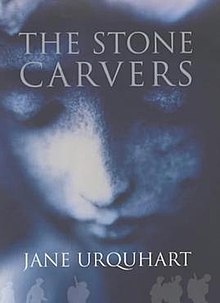
Jane Urquhart, LL.D is a Canadian novelist and poet. She is the internationally acclaimed author of seven award-winning novels, three books of poetry and numerous short stories. As a novelist, Urquhart is well known for her evocative style which blends history with the present day. Her first novel, The Whirlpool, gained her international recognition when she became the first Canadian to win France's prestigious Prix du Meilleur Livre Etranger. Her subsequent novels were even more successful. Away, published in 1993, won the Trillium Award and was a national bestseller. In 1997, her fourth novel, The Underpainter, won the Governor General's Literary Award.

Vimy is a commune in the Pas-de-Calais department in the Hauts-de-France region of France. Located 3.8 kilometers (2.4 mi) east of Vimy is the Canadian National Vimy Memorial dedicated to the Battle of Vimy Ridge and the Canadian soldiers who were killed during the war. The Memorial is also the site of two Canadian cemeteries.

Queen's Park is an urban park in Downtown Toronto, Ontario, Canada. Opened in 1860 by Edward, Prince of Wales, it was named in honour of Queen Victoria. The park is the site of the Ontario Legislative Building, which houses the Legislative Assembly of Ontario. The phrase "Queen's Park" is regularly used as a metonym for the Government of Ontario or the Legislative Assembly of Ontario.

Walter Seymour Allward, was a Canadian monumental sculptor best known for the Canadian National Vimy Memorial. Featuring expressive classical figures within modern compositions, Allward's monuments evoke themes of memory, sacrifice, and redemption. He has been widely praised for his "original sense of spatial composition, his mastery of the classical form and his brilliant craftsmanship".

The Tomb of the Unknown Soldier is a tomb situated before the National War Memorial in Confederation Square, Ottawa, Ontario. The tomb is dedicated to Canadian service members, and holds the remains of an unidentified Canadian soldier who died in France during the First World War; selected from a Commonwealth War Grave near Vimy, in the vicinity where the Battle of Vimy Ridge took place.

The Canadian National Vimy Memorial is a war memorial site in France dedicated to the memory of Canadian Expeditionary Force members killed during the First World War. It also serves as the place of commemoration for Canadian soldiers of the First World War killed or presumed dead in France who have no known grave. The monument is the centrepiece of a 100-hectare (250-acre) preserved battlefield park that encompasses a portion of the ground over which the Canadian Corps made their assault during the initial Battle of Vimy Ridge offensive of the Battle of Arras.

The Dury Memorial is a World War I Canadian war memorial that commemorates the actions of the Canadian Corps in the Second Battle of Arras, particularly their breakthrough at the Drocourt–Quéant Line switch of the Hindenburg Line just south of the town of Dury, Pas-de-Calais, France.

The Le Quesnel Memorial is a Canadian war memorial that commemorates the actions of the Canadian Corps during the 1918 Battle of Amiens during World War I. The battle marked the beginning of a 96-day period known as "Canada's Hundred Days" that saw the crumbling of the German Army and ultimately the Armistice that ended the war. The memorial is located just to the southwest of the village of Le Quesnel, on the road between Amiens and Roye, in northern France.
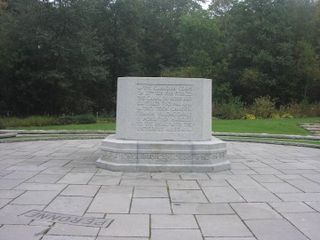
The Bourlon Wood Memorial, near Bourlon, France, is a Canadian war memorial that commemorates the actions of the Canadian Corps during the final months of the First World War; a period also known as Canada's Hundred Days, part of the Hundred Days Offensive.

The Passchendaele Canadian Memorial is a Canadian war memorial that commemorates the actions of the Canadian Corps in the Second Battle of Passchendaele of World War I. The memorial is located on the former site of Crest Farm, an objective captured by the 4th Canadian Division during the assault of 30 October 1917.

The Canadian Hill 62 Memorial is a war memorial that commemorates the actions of the Canadian Corps in defending the southern stretches of the Ypres Salient between April and August 1916 including actions in battle at the St Eloi Craters, Hill 62, Mount Sorrel and Sanctuary Wood. These battles marked the first occasion in which Canadian divisions engaged in planned offensive operations during World War I. In those actions the Canadians reconquered vital high-ground positions that denied the Germans a commanding view of the town of Ypres itself.
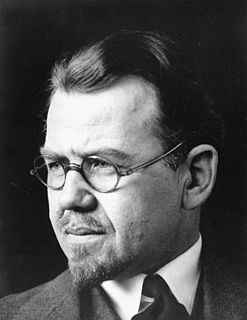
Emanuel Otto Hahn was a German-born Canadian sculptor and coin designer. He taught and later married Elizabeth Wyn Wood. He co-founded and was the first president of the Sculptors' Society of Canada.

Clara Callan is a novel by Canadian writer Richard B. Wright, published in 2001. It is the story of a woman in her thirties living in Ontario during the 1930s and is written in epistolary form, utilizing letters and journal entries to tell the story. The protagonist, Clara, faces the struggles of being a single woman in a rural community in the early 20th century. The novel won the Governor General's Award in English fiction category, the Scotiabank Giller Prize, and the Trillium Book Award.

The Bell Memorial is a memorial designed by Walter Seymour Allward to commemorate the invention of the telephone by Alexander Graham Bell at the Bell Homestead National Historic Site, in Brantford, Ontario, Canada.
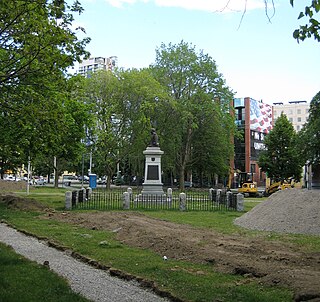
Victoria Memorial Square is a park and former cemetery in Toronto, Ontario, Canada. Established in 1793 as the burial place for those affiliated with the nearby Toronto Garrison. It was the first cemetery to be used by European settlers in what would become the city of Toronto. Originally known as St. John's Square, the park today is part of Fort York National Historic Site, and the site of a monument to the War of 1812 sculpted by Walter Seymour Allward and completed in 1902.
The Canadian Battlefields Memorials Commission was a special commission established by the House of Commons of Canada, on the recommendations of the British Battle Exploits Memorials Committee. The Canadian House of Commons established the committee in September 1920 with the mandate of selecting and establishing First World War memorial sites in France and Belgium.
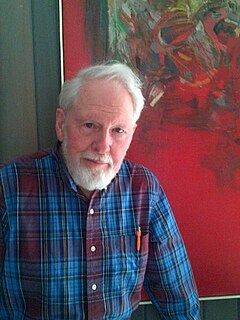
Anthony Morse Urquhart, LL.D. was a Canadian painter. He was recognized in the late 1950s and early 1960s as one of Canada's pioneering abstractionists, having been variously linked with the Toronto painters associated with The Isaacs Gallery and The Heart of London group that included Jack Chambers, Greg Curnoe and Murray Favro.
George Wallace Gouinlock was a prominent Canadian architect. Gouinlock practiced mostly in Toronto, Ontario, Canada, including several designated buildings at Exhibition Place.
The Underpainter is a novel by Jane Urquhart that won the 1997 Governor General's Award for English-language fiction, and in the same year was a finalist for the Rogers Writers' Trust Fiction Prize.
